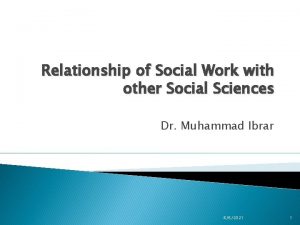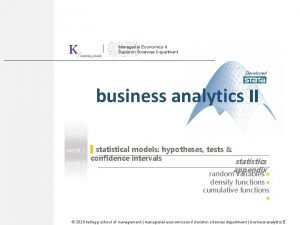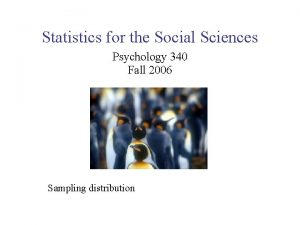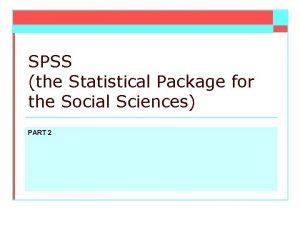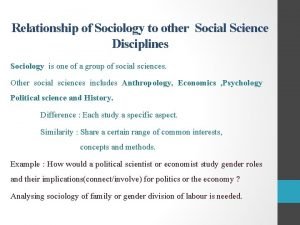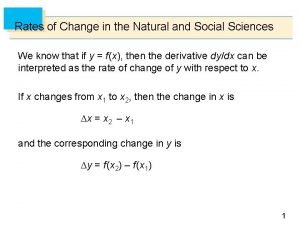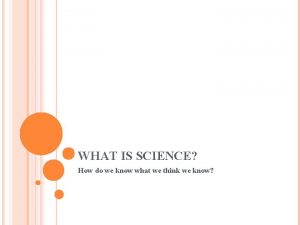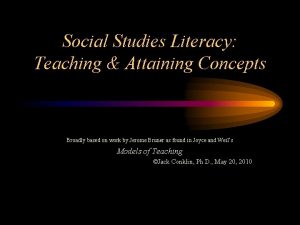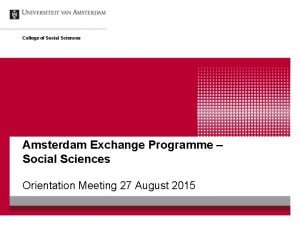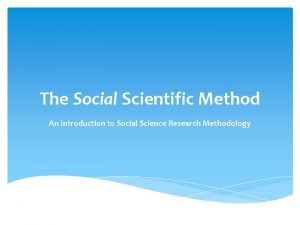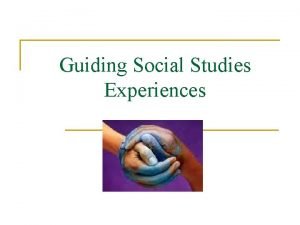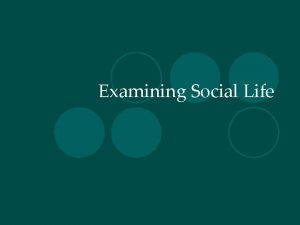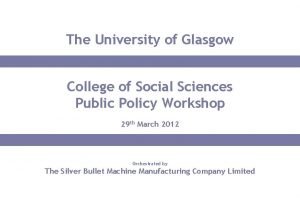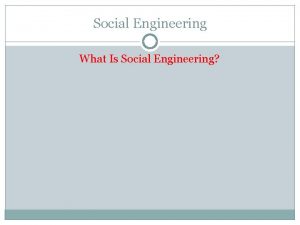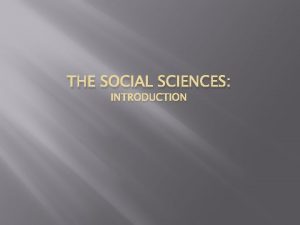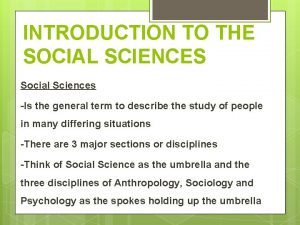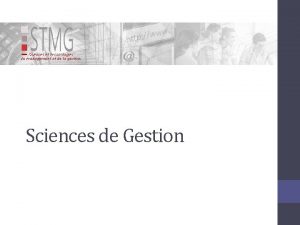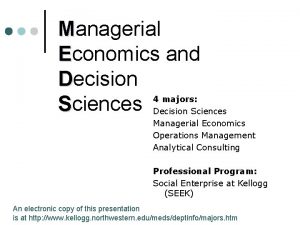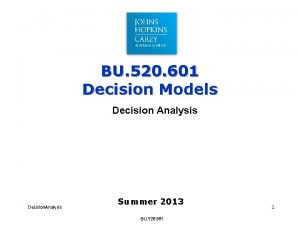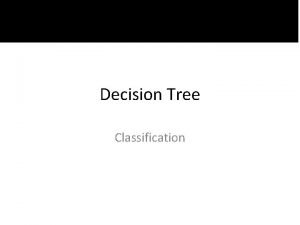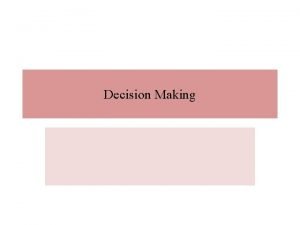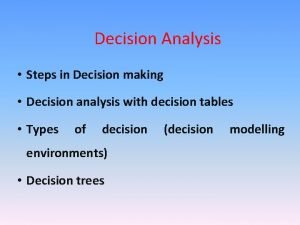Department of Social Decision Sciences Department of Engineering


























- Slides: 26

Department of Social & Decision Sciences Department of Engineering & Public Policy What’s Worth Knowing – and Saying – about the Risks of Terrorism? Decade of Behavior Congressional Briefing Baruch Fischhoff Carnegie Mellon University April 24, 2002

Department of Social & Decision Sciences Department of Engineering & Public Policy with (short-tem) help from: Liz Casman, Matt Dombroski, Sara Eggers, Dalia Patino Echeverri, Paul Fischbeck, Roxana Gonzalez, Umit Guvenc, Jennifer Lerner, Deborah Small, Conrad Steenkamp and support from (over the years): NSF, EPA, NIAID, NIAAA, NIMH, NRC, DARPA/ONR/ARI

Department of Social & Decision Sciences Department of Engineering & Public Policy Overview • • • Psychology of risk (publics, experts) Risk analysis and communication Special challenges of terror A worked example: bioterrorism Special topics (crises, false alarms, second guessing, behaviorally realistic risk analysis, priority setting)

Department of Social & Decision Sciences Department of Engineering & Public Policy Psychology of Risk - Publics (as Actors and Audiences) • Current beliefs are the basis for future understanding (numeracy, literacy) • People have limited cognitive capacity • People use robust, imperfect heuristics • Some concepts are inherently difficult • Emotions can both confound and support the understanding of risk

Department of Social & Decision Sciences Department of Engineering & Public Policy Some Concepts Are Inherently Difficult • • • Very low probabilities Cumulative risk (from repeated exposure) Verbal quantifiers (e. g. , “likely” threat) Experientially unfamiliar events Value uncertainty (what do I really want? )

Department of Social & Decision Sciences Department of Engineering & Public Policy Emotions Confound and Support Understanding • Can mobilize, guide, and paralyze • Can both affect and reflect beliefs • Include: – fear (direct, indirect effects of terrorism) – frustration (with self, authorities) – mourning – solidarity – reflection (about self, society)

Department of Social & Decision Sciences Department of Engineering & Public Policy Psychology of Risk - Experts • Face analogous challenges of understanding • Must create public trust - demonstrating competence and honesty – Realistic assessment of own competence – A clear, consistent public role – Rapid progress on the communication learning curve – Insight into own intuitive psychology of public

Department of Social & Decision Sciences Department of Engineering & Public Policy Risk Analysis • • Identify valued outcomes Identify contributing processes Identify relevant experts Elicit experts’ beliefs, uncertainties, controversies, omissions • Independent peer review

Department of Social & Decision Sciences Department of Engineering & Public Policy

Department of Social & Decision Sciences Department of Engineering & Public Policy

Department of Social & Decision Sciences Department of Engineering & Public Policy Waterborne Cryptosporidium Some Analytical Results • Misplaced priorities -- pointless “boil water” notices • Missed priorities – crypto screening technology – routine water substitution for immunocompromised – broad definition of immunocompromised

Department of Social & Decision Sciences Department of Engineering & Public Policy Risk Communication • Identify common knowledge – What goes without saying? • Identify critical gaps – What’s worth knowing? – Quantitative information (how big is the risk? ) – Qualitative information (what determines the risk? ) • Find a story line (creating coherent mental model) • Evaluate success

Department of Social & Decision Sciences Department of Engineering & Public Policy Special Challenges of Terrorism • Require broadly shared mental models for coordinated action • Events threaten validity of experience (and statistics) • Require theory to augment statistics – Unfamiliar topics (people, places, pathogens) – Unfamiliar interactions (experts without working relations)

Department of Social & Decision Sciences Department of Engineering & Public Policy Special Challenges of Terrorism • Mixed motives of domestic actors – working problem – preserving status – shaping society • Mixed emotions of audience – want facts – want reassurance – want to blame – want solidarity

Emotion & Gender Effects on Terror Risk Judgments Department of Social & Decision Sciences Department of Engineering & Public Policy (mid-November 2001; n=973) Probabilities for Self Probabilities for Other

Department of Social & Decision Sciences Department of Engineering & Public Policy What is the Risk of Anthrax? • A standard representation of disease risk – chance of exposure – chance of sensitivity – chance of detection – chance of treatment • Multiplicative structure of risk – everything needs to go wrong – defense in depth

Department of Social & Decision Sciences Department of Engineering & Public Policy A common structure for bioterrorism risk No risk pexposure Not exposed Not Sensitive Exposed No risk psensitivity Not Detected Sensitive Risk pdiagnosis Treated Detected ptreatment Not Treated Risk

Department of Social & Decision Sciences Department of Engineering & Public Policy What determines probability of exposure? Progress of war Terrorist resources Terrorists’ delivery method Probability of attack Political events Disruption Not exposed Pexposure Our perceived vulnerability Exposed No risk Risk psensitivity Vaccines Detection capability No risk Treatment capability Prob. of interception Intelligence Communication Coordination Surveillance Prob. of avoidance Training Risk pdiagnosis ptreatment

Department of Social & Decision Sciences Department of Engineering & Public Policy Using the Model • What is the risk of anthrax now? (after some event or with new information) • What is the risk of smallpox? (changes in model, parameters) • What matters everywhere? – probability of attack – response capability (monitoring, coordination…) – other valued consequences

Department of Social & Decision Sciences Department of Engineering & Public Policy Special Topics • • • Real-time communication False alarms Second-guessing leaders, officials Behaviorally realistic risk analysis Priority setting

Department of Social & Decision Sciences Department of Engineering & Public Policy Four Priorities from a National Poll (mid-November 2001; n=973) Provide Americans with honest, accurate information about the situation, even if the information worries people. (anger 0) Invest in general capabilities, like stronger public health, more than specific solutions, like smallpox vaccination. (anger -) Deport foreigners in the US who lack visas. (anger +) Strengthen ties with countries in the Moslem world. (anger -)

Department of Social & Decision Sciences Department of Engineering & Public Policy Conclusions Effective risk analysis and communication require: • Quantitative estimates of risk, including the attendant uncertainties • Explicit representation of processes shaping risks • Suitably diverse expertise • Integration of analysis and communication - solve their problem - secure their trust

Department of Social & Decision Sciences Department of Engineering & Public Policy Sources • Casman, E. , Fischhoff, B. , Palmgren, C. , Small, M. , & Wu, F. (2000). Integrated risk model of a drinking waterborne Cryptosporidiosis outbreak. Risk Analysis, 20, 493 -509. • Fischhoff, B. (1992). Giving advice: Decision theory perspectives on sexual assault. American Psychologist, 47, 577 -588. • Fischhoff, B. (1995). Risk perception and communication unplugged: Twenty years of process. Risk Analysis, 15, 137 -145. • Fischhoff, B. (1998). Communicate unto others. . . Reliability Engineering and System Safety , 59, 63 -72. • Fischhoff, B. (1999). What do patients want? Help in making effective choices. Effective Clinical Practice, 2(3), 198 -200. • Fischhoff, B. (2000). Scientific management of science? Policy Sciences, 33, 73 -87. • Fischhoff, B. , Bostrom, A. , & Quadrel, M. J. (in press). Risk perception and communication. In R. Detels, J. Mc. Ewen, R. Beaglehole & H. Tanaka (Eds. ), Oxford textbook of public health London: Oxford University Press

Department of Social & Decision Sciences Department of Engineering & Public Policy Sources (cont. ) • Henrion, M. & Fischhoff, B. (1986). Assessing uncertainty in physical constants. American Journal of Physics, 54, 791 -798. • Lerner, J. S. , & Keltner, D. (2001). Fear, anger, and risk. Journal of Personality & Social Psychology, 81(1), 146 -159. • Morgan, M. G. , Fischhoff, B. , Bostrom, A. , & Atman, C. (2001). Risk communication: The mental models approach. New York: Cambridge University Press. • National Research Council. (1996), Understanding risk. Washington, DC: Author. • OECD. (2002). Guidance document on risk communication for chemical risk management. Draft, 6 March. • Performance and Innovation Unit. (2002). Risk and uncertainty. London: Parliament. • Slovic, P. (Ed. ). (2001). The perception of risk. London: Earthscan. • Mostly available from: baruch@cmu. edu

Department of Social & Decision Sciences Department of Engineering & Public Policy

Department of Social & Decision Sciences Department of Engineering & Public Policy What determines probability of treatment? Terrorists’ delivery method Terrorist resources Probability of attack Our perceived vulnerability Prob. of interception Pexposure Dose No risk Exposure Route Strain No risk Scientific understanding Communication of sci. und. psensitivity pdiagnosis Prob. of avoidance Vaccine status Health status of recipient Detection Capability Concurrent Events Concurrent Conditions Risk Scientific Communication of sci. understanding ptreatment Treatment capability treated Not treated Risk Population heterogeneity
 No decision snap decision responsible decision
No decision snap decision responsible decision Dividend decision in financial management
Dividend decision in financial management The human sciences tok
The human sciences tok Social work relationship with other social sciences
Social work relationship with other social sciences Managerial economics and decision sciences
Managerial economics and decision sciences Statistics for social sciences
Statistics for social sciences Statistical package for social science
Statistical package for social science Social sciences citation index journal list
Social sciences citation index journal list Sociology and other social sciences
Sociology and other social sciences Rates of change in the natural and social sciences
Rates of change in the natural and social sciences Grade 6 natural science
Grade 6 natural science College of humanities and social sciences
College of humanities and social sciences Social sciences examples
Social sciences examples Social sciences examples
Social sciences examples Education desk social sciences uva
Education desk social sciences uva Education desk social sciences uva
Education desk social sciences uva Social scientific method
Social scientific method Ihsst
Ihsst Guiding social studies experiences
Guiding social studies experiences Examining social life
Examining social life Site:slidetodoc.com
Site:slidetodoc.com Cleveland arts & social sciences academy
Cleveland arts & social sciences academy Decision table and decision tree examples
Decision table and decision tree examples Social thinking and social influence in psychology
Social thinking and social influence in psychology Social thinking social influence social relations
Social thinking social influence social relations Defensible decision making
Defensible decision making Electrical engineering department
Electrical engineering department



